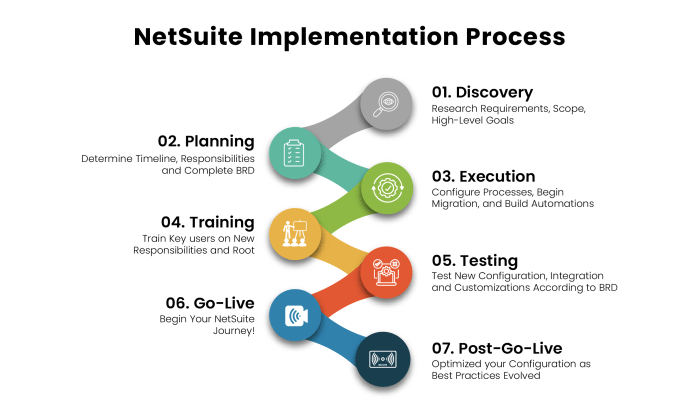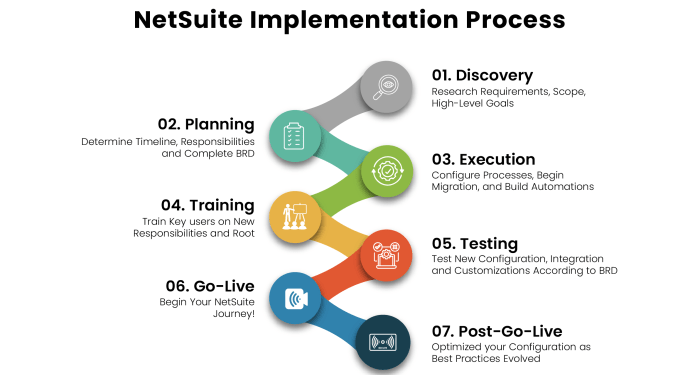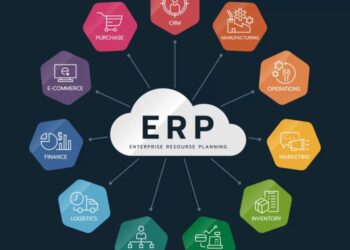Embarking on the journey of Netsuite implementation opens up a world of possibilities for businesses looking to streamline their operations and enhance efficiency. From the initial planning stages to data migration and customization, this process plays a pivotal role in shaping the digital infrastructure of organizations.
Let's delve into the key aspects of Netsuite implementation and uncover the transformative impact it can have on businesses.
Overview of NetSuite Implementation

NetSuite Implementation involves the process of deploying the NetSuite ERP system within an organization to streamline business operations and enhance overall efficiency. This cloud-based software solution integrates various functions such as accounting, inventory management, customer relationship management (CRM), and e-commerce into a single platform.
Key Steps in NetSuite Implementation
Successful NetSuite Implementation typically follows a series of key steps to ensure a smooth transition and maximum utilization of the software:
- Evaluation of business processes and requirements
- Customization and configuration of the NetSuite system
- Data migration from existing systems to NetSuite
- User training and change management
- Testing and quality assurance
- Go-live and post-implementation support
Benefits of Implementing NetSuite
Implementing NetSuite offers numerous benefits to organizations, including:
- Centralized data management for improved visibility and decision-making
- Increased operational efficiency through automation of processes
- Enhanced customer experience with integrated CRM functionality
- Scalability to support business growth and expansion
- Real-time analytics and reporting for better performance monitoring
Pre-Implementation Planning
Thorough planning before starting the implementation process is crucial to ensure a successful NetSuite implementation. It helps in setting clear objectives, defining roles and responsibilities, and identifying potential challenges that may arise during the process.
Key Stakeholders and Their Roles
- Project Manager: Responsible for overseeing the entire implementation process, coordinating with different teams, and ensuring that the project stays on track.
- IT Team: Involved in the technical aspects of the implementation, such as system configuration, data migration, and integration with existing systems.
- End Users: Play a key role in providing feedback, testing the system, and ensuring that the solution meets their requirements.
- Executive Sponsor: Provides leadership, support, and resources for the implementation, ensuring alignment with the organization's goals.
Potential Challenges
- Resistance to Change: Employees may resist adopting a new system, leading to delays in implementation and decreased productivity.
- Data Migration Issues: Transferring data from legacy systems to NetSuite can be complex and time-consuming, leading to data integrity issues if not handled properly.
- Lack of Communication: Inadequate communication among stakeholders can result in misunderstandings, delays, and errors during the implementation process.
- Budget Constraints: Unexpected costs or scope changes can impact the budget, requiring careful monitoring and adjustment to avoid project delays.
Data Migration and Integration

When implementing NetSuite, one crucial aspect to consider is data migration and integration. This process involves transferring existing data into the NetSuite system and ensuring seamless communication between NetSuite and other existing systems within the organization.
Data Migration Process
Data migration involves extracting data from legacy systems, cleaning and transforming the data, mapping it to the appropriate fields in NetSuite, and finally loading it into the system. It is essential to ensure data accuracy, consistency, and completeness throughout the migration process to prevent any issues post-implementation.
Importance of Integration
Integrating NetSuite with existing systems such as CRM, ERP, and other business applications is crucial for streamlining operations and ensuring data consistency across the organization. Integration allows real-time data synchronization, eliminates manual data entry errors, and provides a comprehensive view of the organization's data.
Best Practices for Data Migration and Integration
- Plan and document data migration requirements and mapping processes thoroughly before beginning the migration.
- Conduct data cleansing and validation to ensure data accuracy and integrity.
- Test data migration processes in a sandbox environment before going live to identify and resolve any issues.
- Utilize automated tools and scripts to streamline the migration process and reduce manual errors.
- Collaborate closely with IT teams, stakeholders, and end-users to ensure a smooth transition and address any concerns promptly.
Customization and Configuration
When it comes to customizing and configuring NetSuite, businesses have a wide range of options to tailor the system to their specific needs
. Customization allows for the creation of new functionalities or modification of existing ones, while configuration involves setting up the system's parameters to align with the business processes.Customization Options in NetSuite
Customization in NetSuite can be achieved through SuiteScripts, SuiteBuilder, and SuiteFlow. SuiteScripts allow for the creation of custom scripts to automate processes or add new features. SuiteBuilder provides a visual interface to customize forms, fields, and records without the need for coding.
SuiteFlow enables the creation of custom workflows to streamline business processes.
- Custom scripting with SuiteScripts
- Visual customization with SuiteBuilder
- Workflow automation with SuiteFlow
Configuration Approaches in NetSuite Implementation
When configuring NetSuite, businesses can choose between out-of-the-box configurations or more complex custom configurations. Out-of-the-box configurations involve using standard settings and features provided by NetSuite, while custom configurations require more advanced setup to meet specific business requirements.
- Out-of-the-box configurations for quick setup
- Custom configurations for tailored solutions
Enhancing System Performance through Customization and Configuration
Customization and configuration can greatly enhance system performance by optimizing workflows, automating repetitive tasks, and improving user experience. For example, creating custom dashboards can provide real-time insights for better decision-making, while automating approval processes can streamline operations and reduce manual errors.
- Optimizing workflows for efficiency
- Automating repetitive tasks for time savings
- Improving user experience for increased productivity
Training and Change Management
Training employees during NetSuite Implementation is crucial for the successful adoption and utilization of the new system. It ensures that employees are equipped with the necessary skills and knowledge to effectively use NetSuite in their daily tasks. Change management, on the other hand, focuses on guiding employees through the transition process, addressing any resistance or challenges that may arise.
Significance of Training
- Training helps employees understand the features and functionalities of NetSuite, allowing them to maximize its use in their roles.
- It increases employee confidence and productivity by providing them with the necessary tools to perform their tasks efficiently.
- Proper training reduces errors and ensures data accuracy, contributing to overall business efficiency.
Strategies for Effective Change Management
- Communicate the reasons for implementing NetSuite clearly to employees, highlighting the benefits and addressing any concerns they may have.
- Involve employees in the decision-making process and provide them with opportunities to provide feedback and suggestions.
- Assign change champions or advocates within each department to facilitate communication and support during the transition.
- Offer continuous support and training throughout the implementation process to address any issues or questions that may arise.
Tips for Ensuring a Smooth Transition
- Provide hands-on training sessions that simulate real-world scenarios to help employees understand how to apply NetSuite in their daily tasks.
- Encourage open communication and feedback to address any concerns or resistance early on and make necessary adjustments.
- Recognize and reward employees who embrace the change and demonstrate proficiency in using NetSuite.
- Offer ongoing support and resources post-implementation to ensure employees continue to adapt and utilize NetSuite effectively.
Closing Summary
In conclusion, Netsuite implementation stands as a cornerstone in revolutionizing business processes, fostering growth, and driving success. By embracing the best practices Artikeld in this guide, organizations can navigate the complexities of implementation with confidence and achieve optimal results.
Expert Answers
What is Netsuite Implementation?
Netsuite Implementation refers to the process of setting up and configuring the Netsuite software to meet the specific needs of a business. It involves tasks such as data migration, customization, training, and integration.
Why is pre-implementation planning important?
Pre-implementation planning is crucial as it helps in defining project scope, setting goals, allocating resources, and identifying potential challenges early on. This phase lays the foundation for a successful implementation.
How can data migration be seamless?
To ensure seamless data migration, it is essential to clean and organize data beforehand, map out data migration strategies, conduct thorough testing, and involve stakeholders at every stage of the process.
What are the benefits of training employees during Netsuite Implementation?
Training employees ensures that they are equipped with the necessary skills to effectively use the Netsuite software, leading to increased productivity, efficiency, and user adoption. It also helps in minimizing resistance to change.








![Best Construction ERP Software [2024 Edition]](https://health.bandungnews.id/wp-content/uploads/2025/10/Top-10-Best-Construction-ERP-Software-to-Use-in-2024-1-120x86.jpg)



